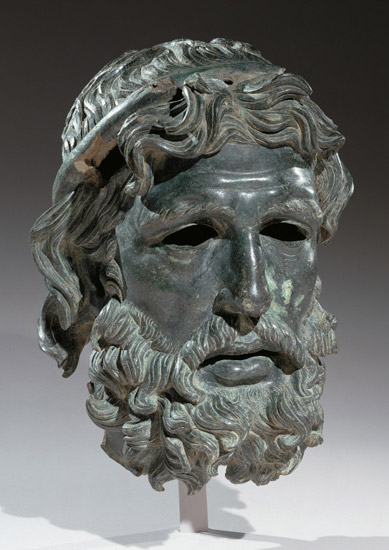
Today, February 25, at 3:30 p.m. at the National Gallery of Art (NGA) in Washington DC, Gregory Nagy and Gloria Ferrari Pinney are holding a panel discussion on “A poet or a god: The Iconography of Certain Bearded Male Bronzes.” This is the second of two panel discussions coordinated with Harvard’s Center for Hellenic Studies to highlight the exhibition, Power and Pathos: Bronze Sculpture of the Hellenistic World (showing at the National Gallery of Art in Washington, DC through March 20, 2016).
In his recent posting from 2016.02.18, Greg Nagy talks about the visual power of bronze in ancient Greece, and how this has affected both visual and verbal art of the ancient world.
Nagy starts off with the Homeric passage of Telemachus visiting the stunning palace of Menelaos and Helen, and continues to Telemachus’ address to Menelaos expressing his admiration of the king’s palace on Odyssey 4.71–75:
…what first catches the young man’s eye here is in fact all that shining bronze he sees. And then it’s the gold, then the electrum, then the silver, and finally the ivory. But the first impression is the bronze, all that bronze. The light that he sees streaming from the bronze envelops everything with its radiance, and it’s just like heaven for the young man.
“Thought I’d died and gone to heaven.” The colloquial saying that I just quoted, which has become the title of a popular song recorded in 1991 by Bryan Adams, captures the young man’s awareness that he has just experienced something celestial. The reduced theology of this kind of imagined heaven resembles the celestial realm of the ancient Greek gods. Their ‘sky’ or ouranos, as we read in Homeric poetry, is traditionally visualized as ‘made of bronze’, khalkeos (χάλκεον οὐρανόν, Iliad 17.425). This ancient Greek expression shows its own special kind of reduced theology: from out of the sky, when it’s bright, the gleam of a mighty bronze dome envelops everything on earth. Presiding over this bronze dome is the god Zeus, whose heavenly residence is called the khalkobates dō, ‘the palace with floor made of bronze’ (χαλκοβατὲς δῶ, Iliad 1.426; 14.173; 21.438, 505; Odyssey 8.321)—a residence situated high above Mount Olympus (Iliad 1.426; 21.438, 505).
Nagy continues to draw a parallel between Odysseus when he enters the palace of Alkinoos and his son Telemachus, entering the palace of Menelaos, but what he goes on to explain is that there is something more to the light from the bronze as Telemachus experiences it, which compares to the light that shines from the palace of Zeus himself. That special something is Helen of Sparta, daughter of Zeus in her role as goddess of Sparta.
Relevant to the status of Helen as Spartan goddess of the dawn is the Homeric context of the epithet Dios thugatēr ‘daughter of Zeus’ as it applies to her in the Odyssey (Διὸς θυγάτηρ, 4.227). This epithet was re-assigned in Homeric diction from Eos the goddess of the dawn to other goddesses like Aphrodite. As we see in the Odyssey, Helen was one of those goddesses. And the epithet Dios thugatēr ‘daughter of Zeus’ applies to her at a very special epic moment in the Odyssey (again, 4.227): at this moment, we can see that she has finally left behind her temporary human existence at Troy and has returned to her permanent divine existence at Sparta.
The gleam that blinded Homer
In exploration of the gleaming light emanated from bronze, professor Nagy explores different accounts of how Homer was blinded. For Nagy, as he argues in his posting and has also argued in his book Homer the Preclassic, it is the gleam from Achille’s armor, the blinding brightness of which is expressed in the Iliad, that blinds Homer. This very substance of Achilles’ bronze armor, as Nagy will go on to argue, is “a fitting symbol for the concept of the Bronze Age as the age of heroes.”
This radiant gleam, becoming universally visible as its light continues to spread all the way up to the aether, projects the world of heroes that we see pictured on the Shield. It is a picture of the Bronze Age, mirrored by the bronze of the hero’s Shield. With its vast array of details, this stupendous picture gives off a most dazzling view of the heroic age. And, as we just saw in the Life of Homer traditions, it was the gleam given off by the bronze armor of Achilles that dazzled Homer to the point of blindness (Vita 6.46–50). To say it another way: the picture of the Shield as envisioned by Homer is being projected, as it were, by its blinding gleam.
The gleam of the bronze Shield emanates not only from its form but also from the content of that form. The gleam comes not only from the armor, that is, from the shining metal of the bronze surface. The gleam comes also from what the armor means. That meaning is conveyed not only through the simile of the hero’s tumulus as a lighthouse but also through the picture made by the divine metalworker on the shining bronze surface of the Shield. In this context, I emphasize the Homeric description of Hephaistos as a khalkeus ‘bronzeworker’ (Iliad 15.309). The picture projected by the gleam emanating from the bronze Shield is a picture made by a bronzeworker.
